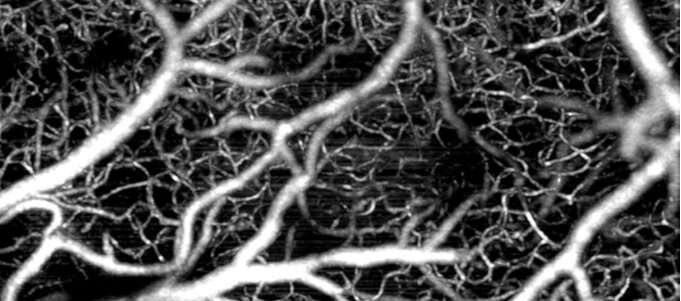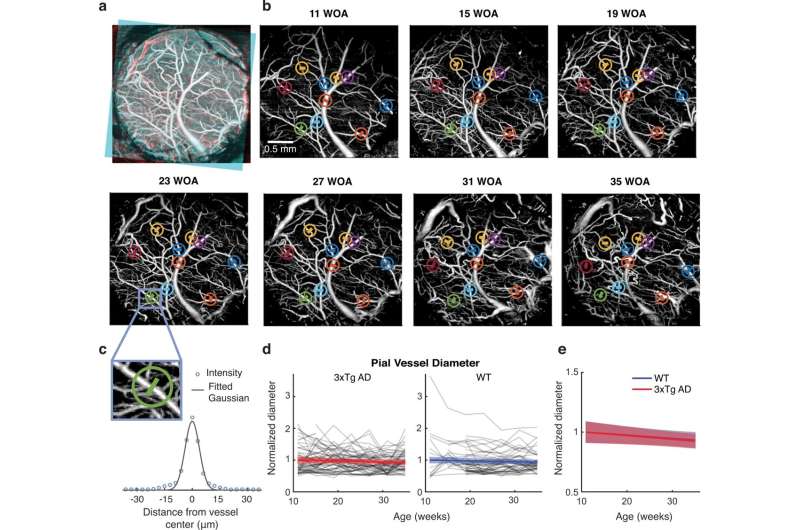This article has been reviewed according to Science X's editorial process and policies. Editors have highlighted the following attributes while ensuring the content's credibility:
fact-checked
peer-reviewed publication
trusted source
proofread
New method tracking changes in blood vessels could advance brain disease detection

While age-related brain disorders like Alzheimer's disease often develop slowly across an individual's lifetime, they usually aren't detected until symptoms have already started. With that in mind, teams of biomedical researchers led by Brown University scientists have been exploring for years whether devastating neurodegenerative diseases could be caught decades earlier—perhaps through something as simple as a routine eye exam instead of a battery of diagnostic tests.
In a new study, one of the Brown-led teams describes early steps in making that a possibility. They show in Nature Communications that it is possible to track how blood vessels in the brains of mice change over long periods of time. The results begin to give biomedical researchers a tool to identify and study biomarkers in these blood vessels that may hold pivotal clues to early detection of progressive neurodegenerative diseases like Alzheimer's, Parkinson's, Huntington's disease and multiple sclerosis.
The hope is that they can next use their method to image the retina in mice to look for these biomarkers, and from there scale up to imaging the retina of humans to study and track how the blood vessels change. The work is among a number of research efforts by Brown scientists to catch Alzheimer's early by peeking into the eyes.
"In this paper, we show that using our imaging technology we can image the brain of the same animal over and over again repeatedly for almost one year, measuring the properties of blood vessels of the brain," said senior study author Jonghwan Lee, an assistant professor in Brown's School of Engineering and Carney Institute for Brain Science. "The results potentially open a path to being able to predict when someone is at risk for developing these neurodegenerative diseases and for doctors prescribing early treatments for them."
Tracking how cerebral blood vessels change over extended periods of time in people who develop age-related neurodegenerative diseases, compared to what normal change looks like, has long been a goal for scientists. It's thought that cerebral blood vessels in people who develop brain diseases show signs of degradation and decline decades before symptoms from the disease begin.
"If we can detect the change in the blood vessels in the brain, or in the retina, for long periods of time, it has long been considered to be possible to predict the onset of these kinds of diseases," Lee said.

Challenges in current microscopic methods have made this type of longitudinal tracking extremely arduous, however, requiring various workarounds. The research team—which also included scientists from Brown's Warren Alpert Medical School and School of Public Health—set out to find a more direct approach.
The novel method they created combines advanced imaging techniques and AI algorithms to track changes in the dynamics and anatomy of blood vessels of the brain. The researchers used the method to measure these changes in 25 different mice for more than seven months.
According to the study, the research team focused on a non-invasive imaging test called optical coherence tomography. OCT uses light waves to look through the retina and image blood vessels that surround the optic nerve. The team adapted multiple OCT techniques to image brain blood vessels like pial vessels, cortical vessels and capillary network. They then integrated the OCT methods with image processing algorithms to search for patterns in the data they collected from normal mice and Alzheimer's disease model mice.
Analyzing the data, they noticed differences between normal age-related changes and vascular changes brought on by disease.
"We found several candidate biomarkers like large blood vessels getting thinner and blood flow getting lower, and more interestingly, the network pattern of vessels significantly altering, compared to the normal aging animals," Lee said.
The ultimate goal is to fine-tune the method and gather enough data so that the group's algorithms can analyze and predict through regular eye exams the chance of a person developing neurodegenerative diseases years before they do. The team is a long way off from this goal but is off to a strong start with the proof of concept in mice, which act as model organisms. In the coming years they plan to look closer at the biomarkers they found and identify more. The next step is imaging blood vessels in the retinas of mice.
The work was co-led by Warren Alpert Medical School student Konrad W. Walek, while he was an undergraduate in Brown's Department of Neuroscience, and Sabina Stefan, while she was a graduate student at Brown's School of Engineering. Both worked in Lee's lab. Other Brown authors include Jang-Hoon Lee, Anna H. Kim, Seong Wook Park, Tao Liu, Yu-Wen Alvin Huang and Christopher Moore.
More information: Konrad W. Walek et al, Near-lifespan longitudinal tracking of brain microvascular morphology, topology, and flow in male mice, Nature Communications (2023). DOI: 10.1038/s41467-023-38609-z




















